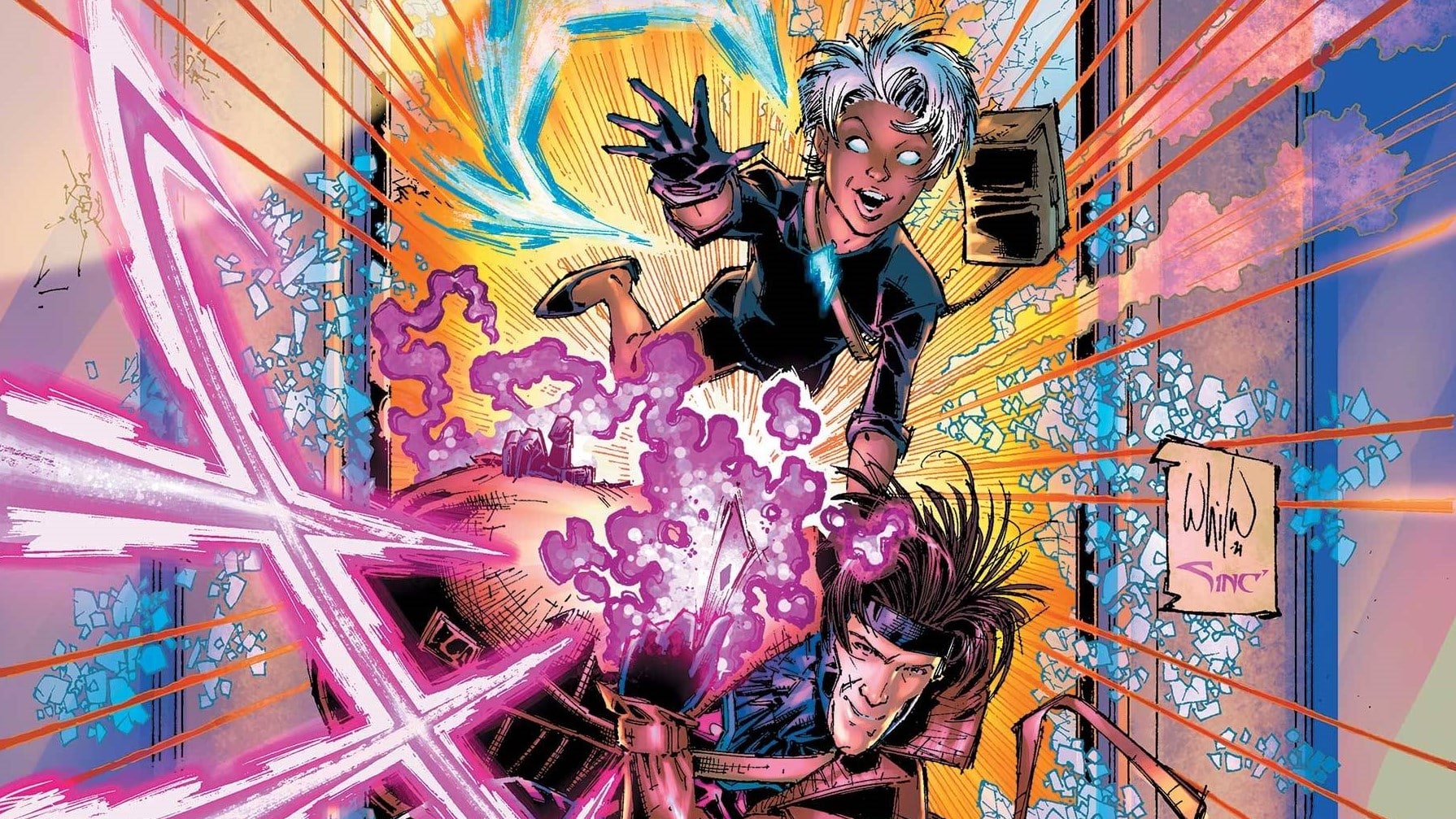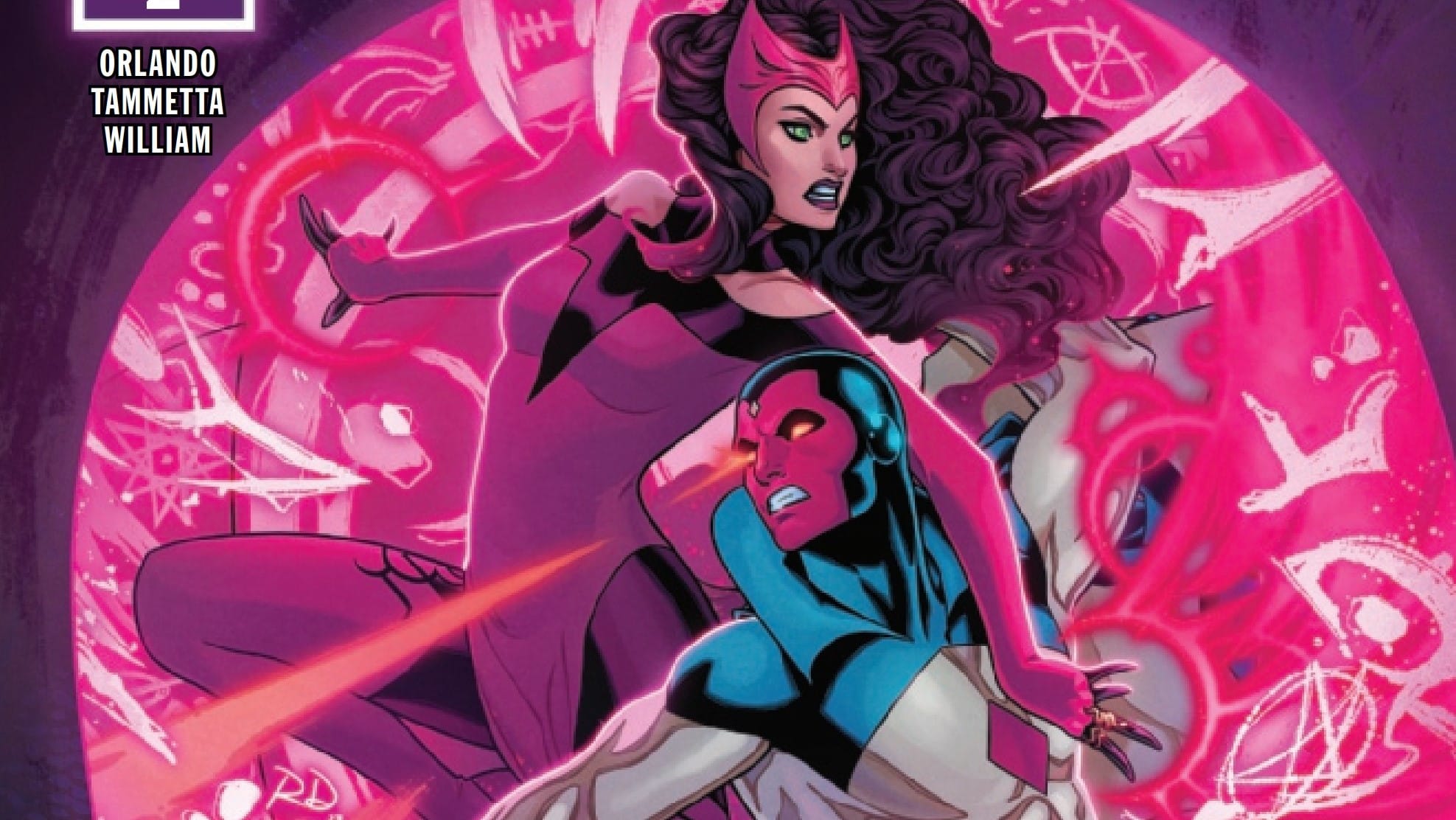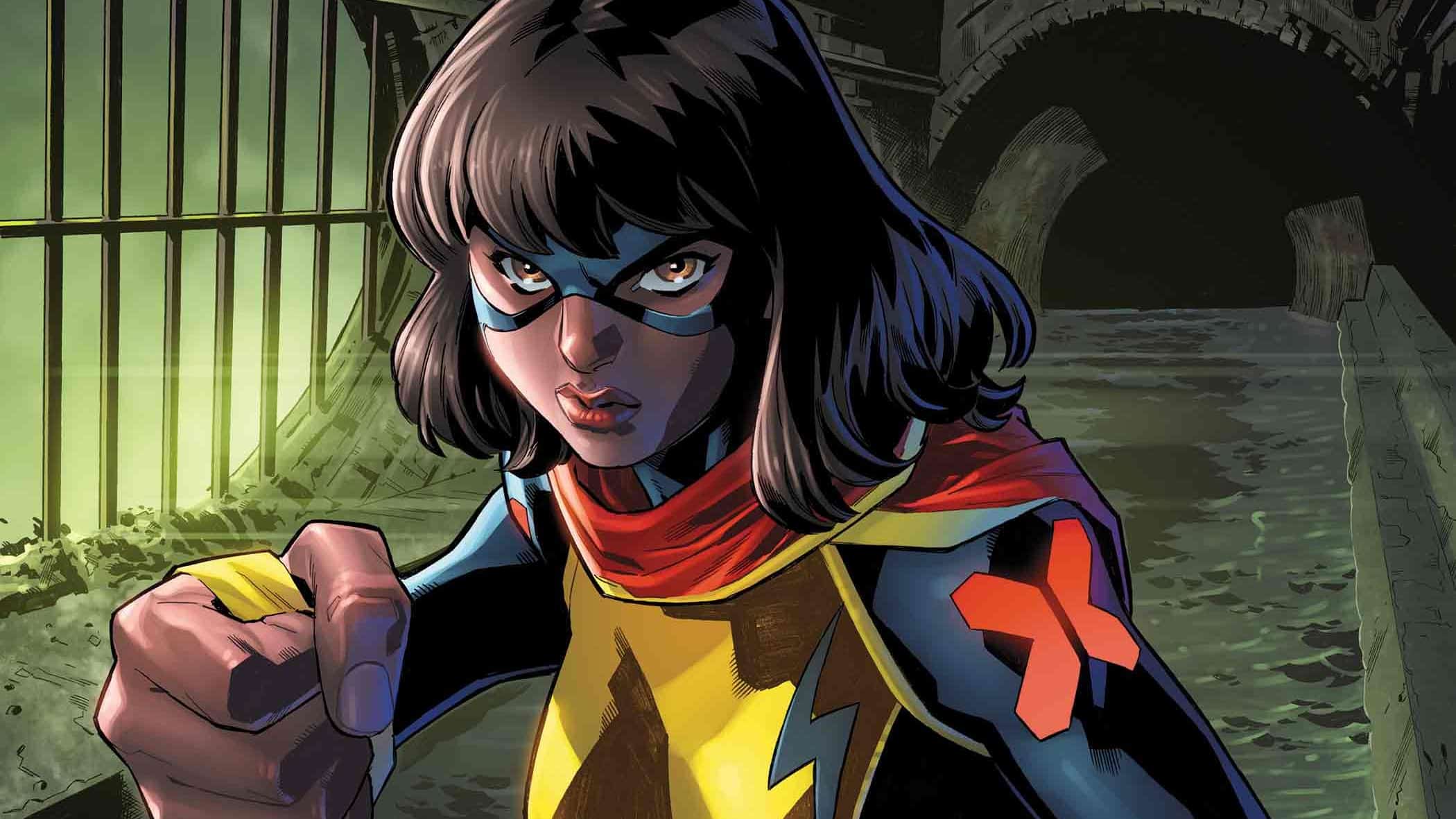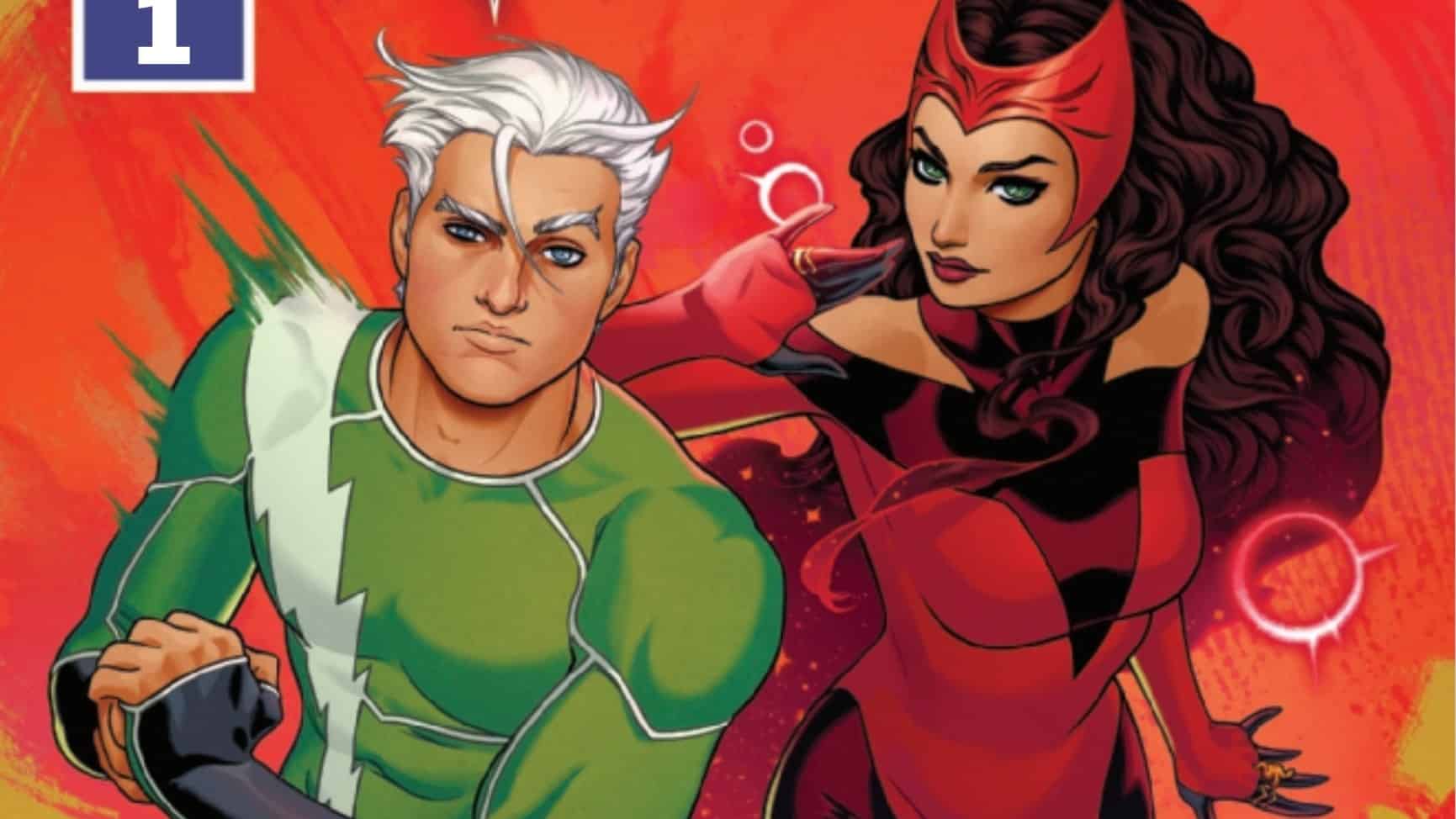Who’s that kid who looks so much like Storm, and what is she doing in Cairo… Illinois? Also, Gambit is there. Chris Claremont returns to chronicle a lost adventure of the Rajin’ Cajun in Gambit #1, written by Chris Claremont, art by Sid Kotian, colors by Espen Grundetjern, letters by Clayton Cowles.
Austin Gorton: Marvel’s sub-universe of nostalgia miniseries written by CB Cebulski’s favorite (and available) writers of the 80s and 90s continues, as “Papa Chris” Chris Claremont returns to one of the final characters created during his first X-Men run in Gambit #1!
Stephanie, are you wary or excited (or a little of both) to return with Claremont to a (very specific) time in Gambit’s past, a world of goofy accents, familiar phrases, and an oddly teenaged Storm?
Stephanie Burt: As perhaps this site’s most ridiculously committed Late Claremont Defender, I’m up for it. Body and soul.
Two of Hearts

Stephanie Burt: We open on Sid Kotian’s slightly goofy, very 80s-looking, delightfully self-conscious theater marquee of a splash page, with box after box of Gambit’s phonetic N’Awlins dialect, lettered in what appears to be Clayton Cowles’s purposeful homage to Tom Orzechowski. ‘Ro (de-aged, teenage, partially depowered Storm) steals some rich dude’s wallet. Tthen Gambit returns it, to teach ‘Ro a lesson. Meanwhile Gambit has filched the dude’s house keys. All part of the plan. The plan, of course, is to throw as many nostalgia bones at longtime X-readers as this issue possibly can, while at some point building up some plot points that we haven’t seen before.
We’ve seen Gambit before in this role– training an unsure teenage superhero who operates outside the law– in Marjorie Liu’s great series about Wolverine X-23 Laura Kinney. But it’s a dynamic I associate very strongly with Wolverine Logan: jaded, wisecracking, wiser-than-thou mentor to a teenage Kate Pryde, Jubilee, Armor, etc. Logan could not do such a thing for ‘Ro because he knew her so well when she was an adult. Gambit, on the other hand? He’s perfect.
And this set of capers seems perfect for a Claremont gig, since he surely had more stories to tell when he left the book in the early 1990s… and we’re not far from that point in continuity here. Retrospective, fill-in-the-gaps books also let Claremont avoid engagement with the current Krakoan continuity…. and yet here’s Moira McTaggart, linchpin of the Krakoa-era retcons, hanging out with the Shadow King. Do you think we’ll see any nods at all to the present-day X-world?
Austin: My first inclination is to say “no.” Claremont has been pretty public (and consistent) in saying he’s not interested in the Krakoa setup, that he bears the creators no ill will but they’re not his X-Men, etc. Yet…there’s Moira, somewhat shoehorned into this story. Yes, she is relevant to this era and the larger Shadow King story Claremont was developing (his last major X-Men arc before leaving the first time). But, as the Shadow King points out, Moira is *already* his thrall at this point in time; their encounter in this issue marks the first time they met in person. Which seems a minor continuity point even for someone like Claremont to make, which makes me think he’s making it for a reason. Will that reason connect back to Moira’s pivotal role in the Krakoa Era? Thanks to her appearance here, I’m now more inclined to say “maybe”.
Speaking of continuity, this story is set in a very narrow window of time: Uncanny X-Men #267 (the issue after Gambit’s accepted first appearance) is split in two. In the first half, Gambit and ‘Ro escape from the Shadow King’s hounds. In the second half, they tussle with Nanny and Orphan Maker (aka breakout stars of the Krakoa Era), at which point Storm’s memories of her previous adult life return (after which she and Gambit meet up with elements of the X-Men in X-Men Annual #14 and then become embroiled in “X-Tinction Agenda”, which is when Storm regains her adult body). In the middle of #267, several weeks pass as Gambit and ‘Ro travel from Cairo, Illinois to New Orleans. This issue (and presumably the series) is set during those weeks, as Storm remains unaware of her full history and association with the X-Men in this issue.
Claremont clearly has an affinity for de-aged Storm; does that version of the character, or this particular status quo of “Storm & Gambit, Traveling T’ieves” do much for you?
Stephanie: Never especially grabbed me when I tried reading and re-reading the original, but honestly? I’m all in here. ‘Ro is bratty, devoted to her independence in a way that seems right for her age (I have a 12-year-old and a 16-year-old), nearly but not quite able to thrive on her own. She also knows she has a lot to learn. And she’s drawn as a kid, in a way that works well here, and might not work well in a book where she’s surrounded by adult teammates.
Austin: Oddly enough, I too found myself enjoying this more than the original Gambit/’Ro stories. Gambit’s original introduction occurs at something of the nadir of Claremont’s run for me: deep in his “non-team” experiment (in which Uncanny X-Men chronicled less a team of X-Men and more the adventures of characters who were once X-Men, clustered into little sub-groups, each doing their own thing) and during a period of artistic transition for the series between Marc Silvestri and Jim Lee (which, combined with bi-weekly shipping, meant a bunch of issues with inconsistent and often subpar art). It’s a period of his run in which I respect what Claremont is trying to do more than I enjoy what’s actually on the page.
Yet, this issue is a lot of fun. Kotian’s art helps, as it brings a lot of energy and characterization to the page, becoming manga-esque at times (such as the sequence when ‘Ro pies the Shadow King). It also helps that Gambit is much more of a known quantity now than during the original “Gambit/’Ro” stories, and that the mystery of Storm’s transformation is no longer a driving concern, making it easier to enjoy the story on its own merits than wondering what the heck is going on.
Queen of Clubs

Stephanie: Austin, did you play Claremont Bingo? I did, and I won! Phonetic accent, Storm’s claustrophobia, wordy (by modern standards) first-person captions (I love them), heroes who low-key explain their powers to each other (because every X-Men comic could be someone’s first!), and don’t forget the lessons in geography. Cairo, Illinois is there for the name, but St. Louis is there because Americans really should know something about it, and why not start with the Arch and then move to a giant bridge over the Mississippi River? “How can things be so wrong,” as ‘Ro says, “and feel so right?”
Austin: If you took a shot every time a Claremontism appeared in Gambit #1, you’d be dead. And yet, as you say, there’s a comforting familiarity to it. This is, again, a nostalgic comic, and there’s a reason those exist. For all his tics, Claremont’s dialogue and narration has always had a unique and interesting cadence to it. He’s wordy, but usually for a reason; it’s not excessive so much as baroque. Late Period Claremont rarely hits the highs of his classic period, but I can’t deny there’s something warm and familiar (and enjoyable!) in being enveloped by his prose once again.
Stephanie: Then we get a girl gang with a queer-coded statuesque leader (check your Bingo card), like Callisto but blond with bright colors. I like the way Sid Kotian draws clothes – he’s got an eye for real people’s non-latex outfits, and especially for youth fashion. But I dislike the way Sid Kotian draws Sabine. She’s really the only misfire among the characters; she looks like her head’s not fully screwed on.
As for the action, the girls in the girl gang are fun, and they’re also the junior auxiliary to the Bacchae. “Bacchae be a global clan of woman warriors who chart their origins way back when,” as Remy be saying. “Bacchae” is also a play by Euripides (unnecessary but fun high culture reference: another Bingo square). There’s a fight between Storm and another woman according to gang rules of honor (another square: see also Uncanny X-Men #170; see also Storm: The Arena). And the girl that ‘Ro has to fight is 100% trans: her socks are a trans flag, and she’s named Jazz, and if that’s not a reference, I’ve got adamantium claws.
Austin: The ‘Ro/Jazz fight definitely seemed like a deliberate callback to the Storm/Callisto duel to me. It’s an admirable bit of restraint on Claremont’s part that he didn’t make that subtext text.
The Bacchae are an interesting group: they (and Sabine) were introduced in Claremont’s late 90s Fantastic Four run. Yet in being a secret sect of thieves with intricate rituals and hierarchies (Sabine is in town to get the Bacchae trainees out of the Shadow King’s line of fire), their appearance here calls to mind the Thieves Guild, the ancestral organization of thieves to which Gambit belongs/was the heir apparent, a bunch of backstory stuff that came around after Claremont left and was mostly developed by Howard Mackie. I doubt Claremont is going to do much with the Thieves Guild in this series (and we’ll all be the better for it), but it’s possible his use of the Bacchae is his way of tacitly acknowledging the Thieves Guild by returning to his own quasi-riff on the concept.
Queen of Diamonds

Stephanie: OMG this is fun, even if it’s mostly nothing new. I’m very happy that it exists, so far. (If you want first-rate takes on Claremontian mutants that do indeed feel new, just read Vita Ayala. Seriously, read Vita Ayala.) Austin, did you see anything exceptional that did not feel like Claremont doing Claremont, body and soul? What did you think of the moment when the Shadow King’s current avatar on Earth, FBI guy Jacob Reisz, gets a pie in the face?
Austin: Yeah, that was the moment that stuck out the most to me (in a not good way). I get what Claremont is going for – ‘Ro can’t stop the Shadow King, but she can at least achieve a minor victory and take the piss out of him a bit – and it fills another slight continuity gap by definitively concluding her battle with the Shadow King that started in Uncanny X-Men #265 and then got forgotten during that transition midway through #267. But also, throwing a pie in the face of the Shadow King’s current physical host doesn’t seem like the major victory it’s presented as here (even if just as a moral victory).
Stephanie: That one felt new to me, because it made me laugh. ‘Ro’s goal: “take him by surprise. Make him feel silly.” Not sure if that move will undercut the Shadow King’s grand plans, but it’s fun to see, and it’s in character.
Austin: It does seem in character for Storm (both her “regular” version and ‘Ro). And Kotian sells it. It also highlights something interesting about this issue: as much as it is Gambit #1, ‘Ro is really the central character of the story. She is the one who experiences an arc, who grows as a result of the plot. Gambit exists mostly in the mentor role, guiding her through that arc. All of which works! But it is still worth pointing out, given who the title character is.
Stephanie: I’m on record disliking the Shadow King as a villain, because his whole look originates in so much orientalism and even more prejudice against big/ round/ fat people. But he’s sure a scary guy, a worthy opponent, a good way to pivot from horror to adventure to superhero business and back again. Also he’s got psychic octopus tentacles. One of which becomes his tongue.
Austin: I have complicated feelings about Shadow King as a villain. On the one hand, he’s the last great Claremont Dangler, as his plans for the villain (which would have stretched all the way out to Uncanny X-Men #300) were cut short by Claremont’s ouster, making Shadow King intriguing as the personification of a wistful “what if Claremont had stuck around?” sentiment. Yet at the same time, he comes with all the unfortunate baggage you mentioned, and is also…kind of boring? Like, he’s mostly evil for the sake of being evil. That can be fun in small doses, it’s tough to build engaging longform arcs around characters like that.
But it does feel, by the end of this issue, like Shadow King has been shuffled off stage/back to the narrative unfolding in the X-Books circa 1990, as another character – another thief – enters the story.
Stephanie: It’s Lila Cheney time! And space opera time!
Austin: Introduced via another character introduced in Claremont’s FF, a character with a simple, on-the-nose name (a bounty hunter named…Bounty). It’s another Claremont trope! Drink!
Stephanie: The Space Marshals who set out to catch Lila Cheney look like throwbacks not so much to Claremont’s X-comics as to the space nonsense ethos of the 1970s: Claremont and Byrne’s Star-Lord, maybe, or Dave Cockrum’s four-color, ten-planet extravaganzas. Or Mike Grell’s Green Lantern. People who grew up with beautiful video games and 21st century CGI forget that when Claremont began writing comics superhero comics were virtually the only way to suspend your disbelief and really see these spectacular skyscapes, cephalopod-headed aliens, star-spanning modules, and so on week after month after week. TV and movies had aliens, but they couldn’t compete for visual spectacle with Dave Cockrum’s pen.
Do you think we’re gonna see a Lila Cheney concert? Maybe some callbacks to “Steal This Planet,” New Mutants Annual #1? Given the pieces in play, and the creators involved, what would you like to see? Will Remy take ‘Ro into space?
Austin: I’d love to see Claremont dip back into some space opera (something he hasn’t done as much in his later work). I think Kotian will make for a fun collaborator on such a story. Lila’s presence definitely suggests a widening of scope for the series, that it won’t just be five issues of Gambit and ‘Ro training and dodging the Shadow King. Bottom line: I am more intrigued by and excited for this series now than when it was first announced, which seems like the right place to be at the end of the first issue.
X-Traneous Thoughts
- Claremont also used a de-aged child Storm in X-Men Forever, his long-form “What If I’d Not Left the X-Men in 1991?” series.
- Gambit is notably called “LeBeau” in this issue, his canonical given name, and not “Remy Picard”, the name Claremont inexplicably gave him in X-Men Forever.
- Is or was Jacob Reisz (who already appeared in the original Claremont run) a reference to Jacob Riis?
- Uncanny X-Men #267 was published in 1990, and Kotian visually sets this story in that era – see for example the 80s businessman with his comically-large cell phone on the title page – despite the fact that Marvel Time mucks all that up.
- I’ve never been to Cairo, Illinois, but this issue and the original Gambit/’Ro story seem to suggest it is home to more over-the-top mansions stuffed with jewels and cash than I would expect a city with a population of consistently less than 5,000 people to support. [Ed. Note: I have been to Cairo, IL several times, and it’s the most “becoming a ghost town” place I’ve ever been.]
- Like Gambit and ‘Ro, Lila’s appearance here occurs in a narrow sliver of continuity for the charactrer, between when she seemingly died in New Mutants #70 (the conclusion of the abominable Spyder story arc) and when she next popped up in Uncanny X-Men #269, being pursued by the Shi’ar Strike Lord (a Warskrull impersonating Professor X), setting up the series’ post-“X-Tinction Agenda” space arc.







